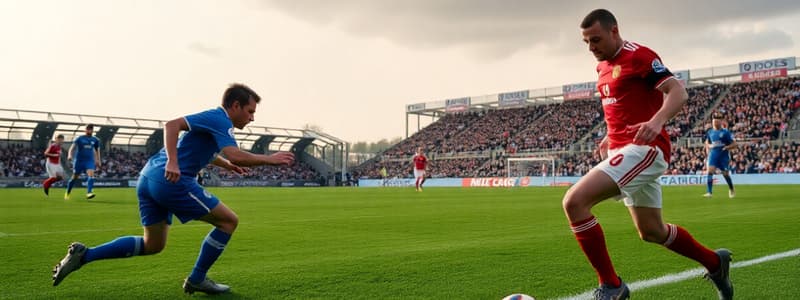Podcast
Questions and Answers
¿Cuál de los siguientes elementos es esencial para el equipo estándar en el fútbol?
¿Cuál de los siguientes elementos es esencial para el equipo estándar en el fútbol?
- Balón (correct)
- Sistema de sonar
- Césped artificial
- Cámara de grabación
¿Cuál es el papel principal de los defensores en un equipo de fútbol?
¿Cuál es el papel principal de los defensores en un equipo de fútbol?
- Defender la portería del equipo (correct)
- Gestionar el flujo del juego
- Marcar goles
- Asistir al árbitro
¿Qué tipo de futbol se considera el más común a nivel mundial?
¿Qué tipo de futbol se considera el más común a nivel mundial?
- Fútbol americano
- Fútbol australiano
- Rugby
- Fútbol asociación (soccer) (correct)
¿Qué función tienen los asistentes del árbitro en un partido de fútbol?
¿Qué función tienen los asistentes del árbitro en un partido de fútbol?
¿Por qué es importante mantener los campos de juego en altos estándares?
¿Por qué es importante mantener los campos de juego en altos estándares?
¿Cuál es el objetivo principal del fútbol?
¿Cuál es el objetivo principal del fútbol?
¿Qué papel desempeña el mediocampo en un equipo de fútbol?
¿Qué papel desempeña el mediocampo en un equipo de fútbol?
¿Quién se encarga de hacer cumplir las reglas durante un partido de fútbol?
¿Quién se encarga de hacer cumplir las reglas durante un partido de fútbol?
¿Cuáles son las características del fútbol moderno que lo distinguen de formas anteriores del juego?
¿Cuáles son las características del fútbol moderno que lo distinguen de formas anteriores del juego?
¿Qué aspecto del juego afecta directamente el flujo del partido y la conducta de los jugadores?
¿Qué aspecto del juego afecta directamente el flujo del partido y la conducta de los jugadores?
¿Qué organización supervisa las competiciones internacionales de fútbol?
¿Qué organización supervisa las competiciones internacionales de fútbol?
¿Cómo impacta el fútbol en las economías de los países?
¿Cómo impacta el fútbol en las economías de los países?
¿Qué provoca la gran base de aficionados del fútbol a nivel mundial?
¿Qué provoca la gran base de aficionados del fútbol a nivel mundial?
Flashcards
Objetivo del fútbol
Objetivo del fútbol
El objetivo del juego es marcar más goles que el equipo contrario introduciendo el balón en su portería.
Número de jugadores
Número de jugadores
Se juega con 11 jugadores por equipo en el campo, incluyendo un portero.
Formas legales de controlar el balón
Formas legales de controlar el balón
Los jugadores pueden mover el balón pateándolo, cabeceándolo o usando otras partes del cuerpo, excepto las manos o los brazos.
Duración del partido
Duración del partido
Signup and view all the flashcards
Reglas del juego limpio
Reglas del juego limpio
Signup and view all the flashcards
FIFA
FIFA
Signup and view all the flashcards
Copa Mundial
Copa Mundial
Signup and view all the flashcards
Cultura del fútbol
Cultura del fútbol
Signup and view all the flashcards
Portero
Portero
Signup and view all the flashcards
Defensa
Defensa
Signup and view all the flashcards
Mediocampista
Mediocampista
Signup and view all the flashcards
Delantero
Delantero
Signup and view all the flashcards
Árbitro
Árbitro
Signup and view all the flashcards
Study Notes
History and Origins
- Football, or soccer, has ancient roots, with variations played in different cultures historically.
- Early forms existed in China, Greece, and Rome, often involving kicking a ball.
- Modern football's development is traced to 19th-century England, with rules codified and the Football Association formed in 1863.
- Codified rules differentiated modern football from earlier, less structured forms.
Key Rules and Gameplay
- The goal is to score more goals than the opposing team.
- Teams have 11 players on the field, plus a goalkeeper.
- Players move the ball by kicking, heading, or other body parts (except hands or arms).
- Games are divided into two 45-minute halves, with possible extra time.
- Offsides, fouls, and penalties regulate player conduct and match flow.
- The referee enforces rules and manages the game.
Playing Styles and Strategies
- Teams and players develop unique playing styles, ranging from attacking to defensive strategies.
- Attack focuses on scoring via quick passing and skillful players.
- Defence aims to prevent goals, using tactical positioning and tackles.
- Midfielders manage transitions between attack and defense.
International Competitions
- FIFA oversees global football competitions, including the World Cup.
- The World Cup is the most prestigious international tournament.
- Continental tournaments, like the UEFA Champions League or Copa America, shape the global football calendar.
Football Culture and Global Impact
- Football creates passionate global support, uniting people across nations and cultures.
- Football is linked to celebrations, national pride, and social gatherings.
- The global following generates revenue through broadcasting, merchandise, and sponsorships.
Equipment and Facilities
- Standard equipment includes ball, playing field, goalposts, and player protection (depending on the level).
- Advanced training facilities and stadiums support players and organizations.
- Maintaining high-quality playing fields is crucial at all levels.
Variations and Other Forms
- Association football (soccer) is the most common form, but variations exist (like American, Australian rules, or rugby football) with distinct rules and equipment.
Key Positions on the Field
- Goalkeepers defend the goal.
- Defenders prevent the opposing team from scoring.
- Midfielders control the game flow.
- Forwards concentrate on scoring goals.
- Specific player roles and responsibilities exist within each team.
Referee and Officials
- Referees interpret and enforce rules.
- Assistant referees aid the referee in decisions.
Studying That Suits You
Use AI to generate personalized quizzes and flashcards to suit your learning preferences.




